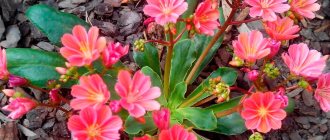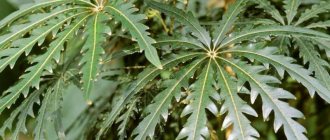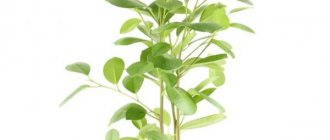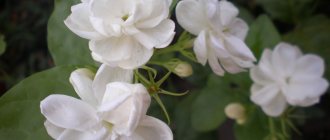How often does home begonia get sick?
With proper care, optimal temperature conditions, lighting and watering, the risk of diseases and pest damage in domestic begonias is minimal. An additional factor of infection can be poor-quality soil and diseased neighboring plants.
Healthy begonia - home decoration
Methods of combating diseases and pests of indoor begonia are varied: from simple and gentle to the most radical. It all depends on the type of disease and the degree of damage to the plant.
Important! In some cases, it is enough to move the pot with begonia to a more suitable place. In other cases, recovery requires measures in several stages.
Below are the main diseases of indoor begonia that gardeners encounter.
Content Features
About 900 plant species today are associated with the name “begonia”. Once upon a time, the famous scientist Charles Plumier saw a flower in the Antilles. The flower owes its name to the governor of Haiti Begon, a philanthropist and organizer of large-scale expeditions. The most popular varieties include royal begonia, red-leaved, “Non-Stop”, spotted, ever-flowering, etc. Care for it depends on the type of crop.
- All varieties known today are quite sensitive to lack of light. Even if the lighting conditions simply change dramatically, this can become stressful for the plant and lead to its disease.
- A good place for begonia would be a window sill with diffused lighting (northwest or southeast windows are optimal).
- Indoor culture categorically does not like drafts and significant temperature changes. If such unfavorable conditions occur during periods of active growth and flowering, this is a direct threat to the plant.
- The normal temperature for the crop will be 15–18 plus degrees in winter, and in summer the figure increases to 22–26. At the same time, in warm weather, monitor the humidity level. Therefore, you can place a cup of water right next to the container with the flower. Today you can find decorative fountains on sale, which would come in handy next to a flower pot - both aesthetically and practically.
- In summer, domestic begonia requires “walking” in the fresh air. But look at the condition of the leaves: if sunlight hits them, there is a risk of burns.
- You need to water the flower moderately. If the variety is tuberous, it is watered exclusively in a tray. Excess water is certainly drained.
- Before flowering begins, it makes sense to spray the leaves with water several times a week. Alternatively, you can wipe them with a wet cloth. But water should not get on the flower itself (they can rot).
- Watering is carried out using melted, settled or filtered water (it should be at room temperature).
- In summer, watering depends on the climate and weather conditions. In winter, watering once a week is enough.
- During the period of active growth and development, be sure to feed the crop. These can be universal fertilizers; nutrient mixtures for ornamental flowering plants are also suitable. The fertilization procedure is carried out twice a month.
Leaves turn yellow, dry and curl
The main reasons why begonia leaves dry out
There may be several reasons for leaves turning yellow and falling. Methods for solving the problem depend on the source.
- Begonia is not watered enough or watered with cold tap water without first settling. Regular, abundant watering with room temperature water that has stood for 48 hours will solve the problem.
- The plant was moved to another place, for example, from a room to a balcony. Sharp changes in temperature, humidity, and lighting levels in some begonias lead to drying out of the edges and curling of the leaves. It is necessary to return the flower to its original place by feeding and removing dead foliage.
- Air dried by central heating radiators will also cause leaves to yellow and wilt. Spraying or a household humidifier will help cope with low air humidity.
- Home begonia prefers bright but diffused sunlight. If there is excessive or insufficient lighting, its leaves will turn yellow and fall off. The salvation will be the organization of an optimal light regime: either additional lighting or shading from the bright sun. In hot weather in summer and when the air is excessively dry in winter, the preparations epin or zircon can be used to activate the vitality of the plant.
Drying begonia leaves
Why do begonia leaves dry at the edges?
When a plant loses its leaves, novice gardeners panic: why is the begonia dying, what to do? The reasons for leaf drying can be different, but the main ones are:
- incorrect choice of detention conditions;
- illiterate care;
- lack of microelements;
- diseases and pests.
Each of these factors is important when growing begonias.
Choosing a place for a pot
Begonia leaves curl and dry photo
The wrong choice of location can lead to illness. Ideally, begonias are suitable for diffused light - eastern and western sides. On southern windows they suffer from direct exposure to sunlight, get leaf burns and dry out soil. They are also uncomfortable in a draft. During the heating season, the pot should not be placed near the radiator.
The optimal air temperature is from 15 to 25 degrees. With a sudden change of location, with different lighting and temperature, begonia may react negatively. When transplanting into a new pot, stems and roots may be damaged and leaves may drop. An improperly cut shoot for replanting can also harm the flower.
Improper watering
Due to lack of moisture, the plant sends a distress signal: the leaves of the begonia dry out. What to do in this case? The flower does not tolerate dry soil or waterlogging. You need to water with soft water when the top layer of soil dries out. Do not allow water to stand in the pan under any circumstances, otherwise the roots and stems will rot.
Dry air
Dry air around begonias also causes the leaves to dry out. This problem is especially relevant when heating appliances are turned on. To increase the humidity level, you need to regularly spray the air around the pot. If moisture gets in, brown spots may appear on the leaf blades and flowers, which is undesirable. A good trick is to place containers of water next to the flower.
Incorrect feeding
If the watering method and place for the flower are chosen correctly, but the flower still dries out, the cause may be improper nutrition. The plant needs feeding, which is carried out twice a month, from March to September. In the spring, complex mineral fertilizers are used, during the flowering period - potassium-phosphorus fertilizers, without nitrogen content. Another reason is overfeeding with mineral fertilizers. Excess fertilizer is indicated by signs such as lethargy, brittleness of leaves, and drying out of their tips.
The buds are falling
What indoor plants must be in the house?
Caring for begonia is quite simple, but mistakes in it can lead to the fact that the plant can shed leaves, flowers, and unopened buds. To help the plant, you need to determine why the begonia is dropping its buds and take measures to eliminate them.
- Unsuitable conditions of detention. Too dry air, roots rotten from excessive watering, direct sunlight, temperatures above 23 °C in summer and below 16 °C in winter are the main reasons why begonia flowers and buds fall off.
- Lack of nutrients. The problem can be solved by fertilizing with complex fertilizers, for example, Kemira Lux. When feeding flowering and preparing to flower begonias, exclude nitrogen; during this period, plants need phosphorus and potassium. Changing the soil will also be beneficial. The ideal composition is considered to be equal parts of turf, coniferous and leaf soil with the addition of small amounts of peat and sand.
- Falling buds can be caused by pests and diseases. The most common are gray rot and powdery mildew. To avoid their appearance, you need to observe the temperature and humidity conditions. Fungicides should be used for control. The appearance of pests such as aphids and spider mites can be another reason why tuberous begonia buds fall off. Parasites, sucking the juices from the leaves, lead to oppression of the plant, and the begonia can drop its buds. Insecticides and acaricides will help to cope with them.
Care Tips
If you are growing flowering begonias, they prefer bright light. Leafy crops prefer diffused light. Do not forget to regularly ventilate the room (but it must be properly ventilated, without drafts).
About transplanting begonias:
- if you managed to keep the flower in a pot in the winter without loss, then in March the plant will survive replanting well;
- remove the begonia from the pot, free its roots from the old soil;
- for a short time, it makes sense to place the begonia roots in a weak solution of potassium permanganate - this will protect the plant from fungal infections (and begonia is predisposed to them);
- if diseased roots are noticed during transplantation, they should be cut off;
- place the flower in a new pot with clean, ready-made substrate - do not pour it to the very top of the pot;
- if the roots grow, you can add more soil (the flowerpot will allow it).
The first month after transplantation requires diffuse lighting and more frequent watering.
The soil for the flower should be light, loose, enriched with organic inclusions. You can “conjure” the soil yourself, or you can buy it ready-made in the store. The ideal soil for begonia is greenhouse soil for indoor crops, high-moor peat, and fertilizers.
In winter, begonia is in a state of sleep. Remember that this is a time of reduced watering, stopping fertilization of the soil. Transplantation cannot be scheduled for the winter! It is very important that the flower accumulates strength over the winter and prepares for spring-summer flowering.
There are small tricks to help the flower not die from excessive dryness. The plant should be placed on an inverted tray; this structure should be placed in a large tray. Expanded clay should be spread around the circumference; it is systematically moistened. The water begins to evaporate, which maintains the desired humidity regime.
Begonia responds gratefully to care; the flower can become the main interior decoration, natural, impeccable and capable of “making friends” with a variety of design trends.
To learn how to save Begonia in case of illness, watch the following video.
Spots on leaves
The appearance of spots on the leaf blades means that the flower is experiencing discomfort. If the plant is helped in a timely manner, the development of the disease and its death can be avoided.
Begonia has brown spots on leaves
Dracaena - flower diseases and how to deal with them
There may be several reasons:
- insufficient watering and low air humidity. In this case, it is worth changing the watering scheme and increasing air humidity;
- fungal infection of the substrate. In this case, brown spots appear on the begonia's leaves, which eventually become covered with a gray coating. The diseased plant should be isolated, the soil should be changed and the plant should be treated with a fungicide.
White spots
They appear due to diseases:
- white weeping spots with a gray coating - gray rot. Isolation, fungicide and microclimate optimization will help;
- white powdery spots are a sign of powdery mildew. Control methods are the same as for other fungal diseases.
Yellow spots and rings accompanied by leaf deformation
Unfortunately, the begonia is infected with the cucumber mosaic virus.
Note! There are no means to combat this disease. The plant needs to be destroyed urgently.
When improper care is to blame
Begonia is considered a capricious plant. The flower requires constant attention and care. In their absence, he begins to get sick. Timely changes in maintenance conditions will help save the plant from death.
Appearance of the plant with proper care
The main problems caused by errors in care:
- Sudden stretching of shoots - occurs due to improper lighting, when transplanting into a cramped container or lack of microelements.
- A sticky coating on the leaves appears during the initial stage of flower rotting. The main reasons are waterlogging of the soil and increased levels of humidity in the room. You can cure a flower by removing the affected parts and adjusting the watering and lighting regime. Recovery is also facilitated by treatment with a solution of Euparen, Fundazol or Topsin.
- Begonia stops growing - this is caused by waterlogging of the soil. Changing the soil and significantly reducing watering will help restore development.
- Reddening of the leaf blade in spring is most often due to an excess of light.
- Powdery mildew infection is also caused by errors in care. Reducing watering, reducing indoor humidity, increasing the temperature and completely eliminating drafts will help save the situation.
- The appearance of false scale insects on a flower is caused by a draft or the presence of an infected plant near the begonia. The insect lives inside the stems and ultimately leads to the death of the entire bush. When the first signs of infection appear, it is necessary to manually treat the affected areas with an infusion of garlic or onion. The operation is carried out until it is possible to completely get rid of the insects.
- The appearance of whiteflies, which multiply very quickly, is the result of improper care and non-compliance with the rules of basic agricultural technology. You can save the flower if you treat it with a strong soap solution. Every damaged leaf must be destroyed immediately. Sprinkling with a soap solution is carried out until all pests disappear.
On a note! Stopping the growth of begonia is sometimes caused by a period of dormancy. In spring, flower development will resume.
Diseases of flowering begonia
During the flowering period, begonias are even more demanding in terms of conditions of maintenance and care. The formation of buds, flowering, and the formation of seeds require increased expenditure of vitality. Even a slight deviation from the norm will cause illness.
- Withered or dry leaves - non-compliance with the humidity regime. A native of the humid tropics, it is very demanding in terms of humidity, but is not resistant to rot that appears as a result of excessive watering.
- Yellow leaves - excessive moisture with lack of heat. With this regime, begonias have problems with flowering, the leaves may turn red and curl.
- Root rot is an indicator of excessive watering. Dry the soil urgently and optimize watering, otherwise the flower will die.
- Rotting of leaves, buds, buds. If the bases of the stems are healthy, it means that the plant is sprayed too often, which is contraindicated.
- Flowering begonias are affected by downy mildew (pernosporosis). Spores of this type of fungus are activated by increased humidity of the air and substrate. When the disease occurs, white fluffy spots appear on the leaves, quickly spreading throughout the plant and leading to the death of the shoots.
Leaves, stems, roots rot
Why does begonia rot? Various types of rot are fungal in nature and can be localized on different parts of the plant. Some fungi take over the plant within a few days, and it is almost impossible to fight them. In simpler cases, isolating the flower and prompt treatment with fungicides will help.
The cause of putrefactive processes is a violation of growing conditions:
- excess air humidity;
- when spraying, drops of water fall on leaves, petioles and growing points;
- poured substrate;
- lack of ventilation;
- insufficient lighting;
- indoor air temperature is below 19 °C in summer and 16 °C in winter.
Note! After identifying the reasons, you need to draw the right conclusions and correct the shortcomings in the maintenance of begonias.
Other diseases
Begonias have several specific diseases and reactions to the environment:
| Problem | Solution |
| Young leaves are too small and pale | Feeding with nitrogen fertilizer is required. |
| Begonia leaves curl | Leaves begin to curl when it is too hot and dry. You need to adjust the settings. |
| The plant standing in the kitchen has drooped | Poisoning by natural gas combustion products. You need to move the flower to a safe place. |
| Leaves fall in winter | Too cold. The temperature needs to be adjusted. |
| Bubble spots. The leaves turn black. | Bacterial wilt. It needs to be treated with an antibacterial drug. |
Diseases that cannot be cured
Begonias have a number of diseases that cannot be treated. If their symptoms are detected, the plant should be destroyed, the pots and window sills should be disinfected, and neighboring flowers should be quarantined.
Incurable diseases include:
- nematode infection. Discolored leaves, sagging appears on the roots;
- cucumber mosaic. Yellow spots and rings. Leaves are deformed.
Cucumber mosaic
Diseases due to pests and their destruction
Begonia is affected by a variety of pests.
- Spider mite. The leaves become dull, lose color, begin to fade, and cobwebs appear on the lower surface. Treatment with systemic insecticides will solve the problem.
- Nematodes. Their appearance will be indicated by swellings on the roots and lifeless leaves. It is better to destroy the plant immediately.
- Aphid. If the infection is severe, all leaves and buds may fall off. The plant will be saved by treating it with an insecticide and a strong soap solution.
- Greenhouse whitefly. Small white butterflies feeding on plant sap. 40 g of laundry soap dissolved in 10 liters of water will help destroy the pest. Leaves with eggs and larvae must be destroyed before processing.
Whitefly on begonia
- Greenhouse thrips. The plant loses its decorative effect, becomes faded, lifeless, and sheds its leaves. You can fight it with a soap solution or insecticides.
- False shield. The presence of a pest can be judged by the appearance of the insects themselves (brown scales) and sticky products of their metabolic activity on the leaves. The fight against scale insects is not easy, since the pests are protected by shields. A combination of mechanical removal with a brush and treatment with an insecticide will give the result.
Note! Most diseases of domestic begonia are provoked by an unsuitable microclimate, which appears as a result of improper, inappropriate care. The first step in the treatment of such diseases should be a revision of agricultural practices and methods.
Pests
Pests do not spare the flower. They can be dealt with if recognized correctly.
- Greenhouse whitefly. High humidity promotes its appearance. The pest settles on begonia leaves and feeds on the sap of the plant. If you notice that the leaves have faded and begun to dry out, it is likely that a whitefly has already taken advantage of them. The old proven method will help you deal with it - a soap solution: 35 grams of liquid soap per 1 liter of water. Spray a little at a time; soapy water should not get under the roots in abundance.
- The false shield is soft. The most dangerous parasite. It actually settles inside the shoot, blocks its growth, and leads to the drying out of the flower. To get rid of the pest, manual cleaning of the plants is required; a soft brush helps with this. Garlic infusion can also be effective.
- Red spider mite. Its invasion is indicated by a thin cobweb on the stem of the flower. If the crop is already affected, the leaves become marbled in color, they are covered with cobwebs, they begin to turn yellow and slowly fall off (sometimes en masse). In this case, the drug “Decis” will be effective. Most of all, the parasite inhabits the back part of the lower leaves, so inspection of the plant should not be superficial.
- Greenhouse aphid. If widespread, the pest can quickly kill the plant. If the leaves of a flower turn yellow, curl, or buds fall off, it is an aphid. She can fly through a window that was left open. “Aktellik” or “Fufanon” cope well with it. Remember that you need to deal with aphids without delay.
- Leaf nematode. It differs from the root-knot nematode described above. Faded green spots appear on the leaves, and soon they will begin to turn brown. The Heterophos solution will help eliminate the pest.











